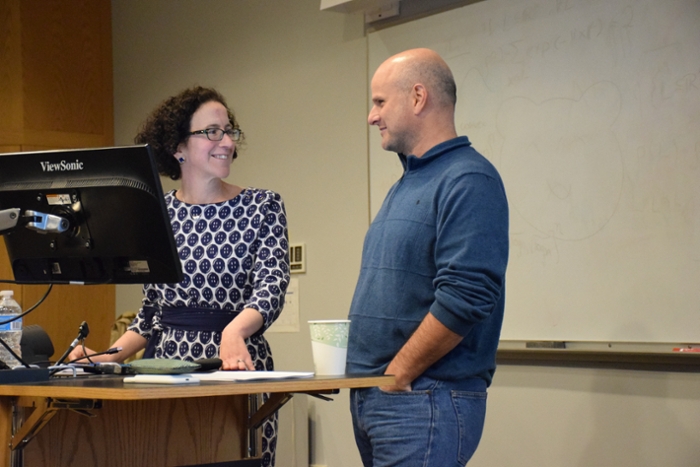The Effects of Subsidizing Health Insurance
MIT’s Amy Finkelstein discusses value of expanded Medicaid program
Get all our news

On October 24, MIT's Amy Finkelstein gave the first "Who Needs to Do What Differently?" seminar. Northwestern development economist and IPR associate Dean Karlan launched the series to examine how research does, or does not, influence policy.
The Medicaid program, which expanded in 2014 under the Affordable Care Act, now spends $550 billion per year. Meanwhile, the heavily subsidized health insurance exchanges around the United States cost about $40 billion per year. What exactly does this money do for low-income recipients?
Economist Amy Finkelstein of the Massachusetts Institute of Technology addressed this timely question in a presentation on October 24 at Northwestern University. Her talk launched the “Who Needs to Do What Differently?” seminar series, organized by Kellogg development economist Dean Karlan. IPR and the Global Poverty Research Lab at the Buffett Institute for Global Studies, where Karlan is a fellow, co-sponsor the series.
Karlan said he created the series to examine how research does and does not influence policy, both domestically and abroad: “What are the obstacles to using evidence? Who is going to object, and why? What has already happened, or what needs to happen? Is more research needed before anything is done in policy?" he asked. "If all reduced to one question, it'd be 'who needs to do what differently because of the research?'—hence the name of the seminar series.”
One of the U.S.’ leading experts in healthcare economics, Finkelstein outlined her research on an experiment in Oregon that expanded Medicaid to individuals who did not qualify for the national program, even though they were financially eligible, because they were able-bodied.
The state program began enrolling people in 2008 using a lottery system, after having been closed to enrollment since 2004 due to budget issues.
“This provides the opportunity to bring a randomized evaluation to answer the question of what does Medicaid coverage do,” Finkelstein explained.
Finkelstein and her co-authors found that hospital visits increased by about 30 percent in the 18 months after individuals enrolled in Medicaid. In fact, the program increased healthcare use across the board—increasing emergency department visits, as well as primary care use and preventive care.
Despite seeing doctors more, Medicaid recipients were paying less. The program increased enrollees’ economic security, reducing their medical debt and out-of-pocket expenses. They were also less likely to borrow money or skip paying nonmedical bills to pay for their medical care.
“Medicaid looks like it’s doing what it’s supposed to in terms of protecting people financially against catastrophic expenditures,” Finkelstein said.
Medicaid enrollees also reported improved health—although it is important to note that this was self-reported information. In fact, the program had no detectable impact on physical health measures such as blood pressure and cholesterol. It did, however, seem to reduce depression rates as measured by a screening questionnaire, perhaps because recipients were not as stressed by money matters.
Another less apparent effect: Enrollees were not the only ones to benefit from expanding Medicaid.
Finkelstein explained that the low-income uninsured only pay 20–35 cents of every dollar spent on their medical care. This means the rest of the money is coming from elsewhere—typically charity care from nonprofit hospitals and public clinics.
She estimates that for every dollar of Medicaid spending, about 60 cents actually went to providers of charity care for the low-income uninsured. These hospitals and clinics are therefore an important beneficiary of Medicaid coverage.
Finkelstein also discussed the value of subsidized health insurance to an individual as a welfare or redistributive policy. The social value of expanding Medicaid appears greater than its net costs, but such programs may deliver less “bang for the buck” than cash transfers such as the Earned Income Tax Credit, she noted.
“Given a reasonably redistributive social welfare function, we would likely be comfortable as a society subsidizing health insurance to low-income individuals, but we probably would benefit the low-income population more if instead we just gave them cash,” she noted. “One way to think about it is that every dollar is going directly to recipients, rather than 60 cents on the dollar going to someone else.”
Amy Finkelstein is the John and Jennie S. MacDonald Professor of Economics at the Massachusetts Institute of Technology.
Published: November 13, 2017.